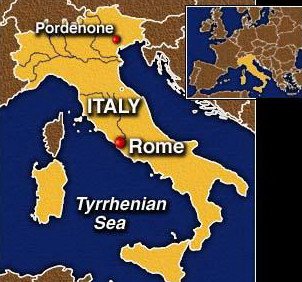Friuli Venezia Giulia - Pordenone

History
Pordenone was created in the High Middle Ages as a river port on the Noncello, with the name Portus Naonis. In the area, however, there were already villas and agricultural settlements in the Roman age.
In 1378, after having been administrated by several feudatories, the city was handed over to the Habsburg family, forming an Austrian enclave within the territory of Patriarchate of Aquileia. In the 14th century Pordenone grew substantially due to the flourishing river trades, gaining the status of city in 1314.
In 1514 it was acquired by the Republic of Venice, under which a new port was built and the manufacturers improved.
After the Napoleonic parenthesis Pordenone was included in the Kingdom of Lombardy-Venetia. The railway connection and the construction of the Pontebbana road implied the decline of the port, but spurred a substantial industrial development (especially for the working of cotton). Pordenone was annexed to Italy in 1866.
The cotton sector, however, decayed after the damage of World War I and the 1929 crisis, to never recover at all. After World War II the local Zanussi became a world giant of household appliances, and in 1968 Pordenone became capital of the province with the same name, including territory belonging to Udine.
After WWII, Pordenone, as well as the rest of Friuli-Venezia Giulia, became garrison for many military units, in order to prevent an eventual Soviet invasion from east. The heavy military presence was an important factor in the economical development of this once depressed area. Pordenone is as now garrison of the 132nd Armored Brigade "Ariete".
U.S. Aviano AFB is located at the base of the Dolomites at the northern end of the Po Valley, the largest agricultural plain in Italy. The base is 35 minutes from skiing at Piancavallo and an hour from the beaches of the Adriatic. The closest large city is Pordenone, about 10 minutes away, and Venice is only an hour and a half away by auto or train.

Landmarks
Corso Vittorio Emanuele II, with its carachteristical Gothic and Renaissance edifices, some with frescoes.
Cathedral of St. Mark (Duomo), built from 1363 in Romanesque-Gothic style and restored in the 16th and 18th centuries. It houses a famous fresco of San Rocco and an altarpiece by the local Renaissance artist Giovanni Antonio de' Sacchis, commonly known as "Il Pordenone". It has a 79 m bell tower.
Palazzo Ricchieri, today seat of the Town Art Museum. It was originally a tower-house from the 13th century, later adapted as a mansion by the Venetian family of Ricchieri.
The Gothic Communal Palace (1291-1395). The loggia, the pinnacles and the watch-tower, designed by painter Pomponio Amalteo, were added in the 16th century.
Palazzo Comunale of Pordenone.The church of the Santissima Trinità ("Holy Trinity"), alongside the Noncello river. It has an octagonal plant and frescoes by Giovanni Maria Calderari, pupil of Il Pordenone.
Castello di Torre ("Tower Castle") (late 12th century), residence of the Ragogna family and now seat of the Western Friuli Archaeological Museum. It was assaulted in 1402 by Imperial troops, who left in place only a tower.
Roman Villa of Torre, remains of a patrician villa discovered in the 1950s.
 Pordenone Links
Pordenone Links
Comune di Pordenone - Sito Web ufficiale
Comune di Pordenone (PN) - Italia: Informazioni
Cerca
Nel Sito e sul Web
Pagine Utili
Elenco Comuni Provincia di Pordenone
Offerte Lavoro Pordenone e Provincia
Cinema a Pordenone e Provincia
Calendario Scolastico Friuli-Venezia Giulia
Principali Città Italiane
Lista di tutti i Comuni










0 Comments:
Post a Comment
<< Home